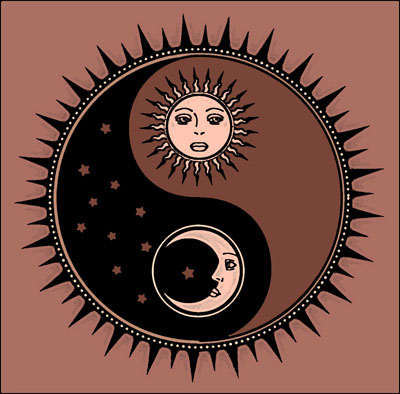Realization in Relation
A Spiritual Relationship
The loving relationship you enter into with a partner, for instance in a marriage, could be a spiritual relationship, wherein supporting each other in one’s inner development and assisting each other in processing and leaving behind both old and new limiting pains becomes a significant component. We’re not just talking about dismantling personal ego-identifications and conditionings that become apparent in that committed relationship, but also about processes of processing and detaching from loss and grief from earlier periods. In our inner liberation process towards self-realization, the committed partner can play a crucial role.
A ‘true relationship’ is therefore a spiritual relationship and is meant for inner liberation. You ‘encounter each other’ in a committed relationship; it can’t be otherwise (and this also applies to a close family relationship). After the initial period where you are fully there for each other, enamored and all, a time comes when differences in approach and opinion start to show. These differences surface where they previously weren’t visible in the other, or perhaps even seemed appealing. The previously unnoticed traits and differing opinions become part of your own inner ‘work area’ in the committed relationship. It’s fairly certain that this is the intention. You didn’t just choose based on similarities, but also definitely based on inherent contrasts and character. You unconsciously chose a partner who can teach you something. That’s why the saying ‘your partner is your best teacher’ exists.
Rooted or Chained
When one is unconscious of oneself and thus in a waking sleep, the relationship is usually based on the mutual fulfillment of needs to maintain a comfort zone. Why? Because the non-spiritual person simply functions better in a comfort zone. Then, as little discomfort or stress as possible is experienced, and things run as smoothly as possible and follow their daily course. A committed relationship gives a feeling of connection with someone, a natural attachment from our Ahamkara. This is also important. Natural attachment is a need from our essence. It provides a grip on life: a kind of ‘anchor’. Then a relationship can arise in which you can express yourself fully. You can then release accumulated tensions and there is mutual support in difficult times. Partners can then discharge and recharge with each other. There’s nothing wrong with that. Moreover, it’s often also more economical to live together due to the high costs in our society. But it can also be as Conny Palmen says: “a very great love can also bring a great feeling of dependence”: a love relationship in which there’s an attempt to not ‘lose’ the other in any way. A spiritual relationship is precisely to increasingly accept the other in love and in a certain way even ‘let go’.
Largely due to the need for security, married people and long-term partners tolerate a lot from each other. You don’t want to lose each other because you know what the other has to offer. However, this can result in mutual dependency or even a symbiotic relationship. This can pose problems, but it doesn’t have to if both partners continue to meet each other’s needs and are satisfied with that. If, however, one of the partners becomes dependent on the other, to continue feeling good or to function, it’s almost impossible to have a spiritual relationship with each other.
Area of Work
For someone who wishes to achieve inner liberation, a committed relationship can serve as a constant ‘trigger’ for growth. An opportunity that is often overlooked, given the number of divorces today. All moments perceived as challenging, which result in ‘trouble’, point to our own inner ‘work area’. Every relational ‘trouble’, such as conflict, arguments, or feelings of separation, arises from unmet needs. These often originate from the identifying ego, like an obstinate insistence on ‘how things should be’ in the relationship. But deep-seated needs can also stem from our individual essence and can be ancient or possibly karmic in nature. The ‘trouble’ becomes even more troublesome, more intense, and counterproductive when partners refuse to let go of their obstinacy and self-justification.
The more personal mindsets nestle within us as ‘this is true’ and ‘it should be like this’, the harder it becomes in a (committed) relationship. If there’s a hierarchical difference between partners, and one continually conforms to the other’s demands, or even subordinates to them, it can wear both down. Sometimes there’s relational peace from an attitude of ‘let’s not talk about it’, and in this ‘keeping the peace’, no ego dismantling or inner growth is possible. Then, a lot gets swept under the rug, which eventually comes out.
A romantic relationship can truly become a learning experience for those who continue to explore the source of discomfort prompted by their partner. And that’s fine. The partner, in this context, is merely the trigger, or the reason and not the cause of these unsettling feelings. You always experience the stimulus ‘outside’ of you, but the root cause always resides ‘within’ you. If we seek self-realization through inner liberation, it’s not beneficial to end a relationship out of a ‘false’ need for freedom. If someone abandons the relationship because the relational troubles never cease, yet they still deeply love their partner, they are missing out on a golden opportunity. Similar relational issues may arise in a subsequent relationship if we’re not aware of this.
A committed relationship, therefore, is a golden opportunity, a situation for personal inner growth and liberation, provided you’re willing to continually examine and abandon old conditionings and mindsets, and dedicate them to your highest essence. Stop projecting dissatisfaction onto your partner (thus avoiding your own inner work), as this doesn’t bring inner liberation and only worsens the situation. Your partner cannot do your inner work, and you can’t change your partner either. It requires constant surrender, in a certain humility, to the other, your partner, and thereby, in essence, to your highest goal. In so-called relational troubles, there’s immense growth potential! It can lead to self-realization.
 The inner world and experiences of partners differ. You cannot change anyone into the image of how you’d like them to be, including your partner. However, you can alert your partner if certain behaviors trigger feelings and conditions within you. You can then ask them, out of love, to be considerate of your sensitivities and growth opportunities at that time. Even if you desire inner freedom, self-realization isn’t straightforward, either due to your nature or because you lack the strength for the surrender of inner tendencies. In such cases, your partner can be understanding of the need for support in this growth process, especially during moments of recurring ‘trouble’. Mutual understanding is necessary, or else an unequal relationship and potential relational hierarchy can arise. This can be mutually agreed upon. In a full-fledged loving relationship, it’s undesirable (and practically impossible) to unilaterally become your partner’s ‘coach’. The art lies in collaborating spiritually, aligning more and more towards the spiritual goal: becoming internally free and realizing oneself within the relationship. A deeply felt understanding that there’s only one Self, and only our identified ego experiences and drives separation and opposition, is extremely helpful here. Moreover, love is essential to all of us. Within it, partners should continuously find each other, ideally.
The inner world and experiences of partners differ. You cannot change anyone into the image of how you’d like them to be, including your partner. However, you can alert your partner if certain behaviors trigger feelings and conditions within you. You can then ask them, out of love, to be considerate of your sensitivities and growth opportunities at that time. Even if you desire inner freedom, self-realization isn’t straightforward, either due to your nature or because you lack the strength for the surrender of inner tendencies. In such cases, your partner can be understanding of the need for support in this growth process, especially during moments of recurring ‘trouble’. Mutual understanding is necessary, or else an unequal relationship and potential relational hierarchy can arise. This can be mutually agreed upon. In a full-fledged loving relationship, it’s undesirable (and practically impossible) to unilaterally become your partner’s ‘coach’. The art lies in collaborating spiritually, aligning more and more towards the spiritual goal: becoming internally free and realizing oneself within the relationship. A deeply felt understanding that there’s only one Self, and only our identified ego experiences and drives separation and opposition, is extremely helpful here. Moreover, love is essential to all of us. Within it, partners should continuously find each other, ideally.
Responsibility
Our center of Reason should take the lead during moments of relational issues, relying on the Buddhi, which lets us know what’s genuinely good for inner development and liberation. You really ought to take each other’s feelings into consideration, while also pointing out each person’s responsibility in their inner work area. Without pushing the other away by giving them the feeling that their development is “their own business”, under the presumption that it isn’t your responsibility. There certainly is a responsibility towards your partner once you’ve chosen each other in a ‘committed relationship’. Living together then enables a deeper process of inner development, as you’re unlikely (and ideally unwilling) to easily escape these triggers.
It’s a subtle play of helping and accommodating each other, by showing genuine interest in each other’s development and liberation, with a keen awareness of maintaining autonomy and recognizing what belongs to ‘you’ and what belongs to the ‘other’. Your partner can’t undertake your development, no matter how much they love you (and vice versa). You really have to do it yourself. By development, I also mean that you continue to seek the silent world that always awaits us behind the restlessness of our agile mind with its tendencies stemming from unresolved matters. As soon as any level of projection arises (like blame-shifting), the subtle process is disrupted, and development halts. Expressing negative emotions further amplifies the inability to become still and observe reflectively. Stop expressing these negative emotions as soon as you realize it’s happening! Recognize that, when you’re in self-remembrance, projection is impossible and negative feelings can be neutrally observed. Internal consideration doesn’t have to lead to projections onto your partner or setting demands, provided you promptly notice it and recognize it as highly undesirable. If in a relationship, one or both partners no longer want to reflect and delve ‘inward’ to investigate their inner blockages, the process of mutual inner development will come to a halt, possibly causing the relationship to stagnate as well.
If inner development within your partnership stagnates, or you notice that living with your partner has led you to an emotional-mental decline distancing you from your soul’s destiny (your blossoming), then it would be wise to consider ending the romantic relationship. This doesn’t mean that the relationship in itself must end, as it can remain valuable in your process towards inner liberation as an ‘awakener’.
Celebrating Life Together
 Learning to ‘celebrate’ life is what we need to do. Mainly by learning to let go of everything that keeps automatically arising and unbridledly takes up space because we don’t genuinely observe it. Celebrating life, regardless of what happens, should be the goal: fully experiencing all the pleasant, all the unpleasant, and all the painful things that inevitably occur in life. Experiencing and sharing this together can be immensely enriching. How we handle it belongs to our personal inner work area, where we are spiritually supported by our partner: mutually supporting without being dependent on a specific behavior from the other to keep feeling ‘good’. Wanting to maintain the comfort zone is our pitfall. Only in symbiotic relationships do partners ensure they maintain their own and each other’s comfort zones as much as possible to prevent discomfort, meaning everything remains the same, and truly becoming internally free remains an illusion.
Learning to ‘celebrate’ life is what we need to do. Mainly by learning to let go of everything that keeps automatically arising and unbridledly takes up space because we don’t genuinely observe it. Celebrating life, regardless of what happens, should be the goal: fully experiencing all the pleasant, all the unpleasant, and all the painful things that inevitably occur in life. Experiencing and sharing this together can be immensely enriching. How we handle it belongs to our personal inner work area, where we are spiritually supported by our partner: mutually supporting without being dependent on a specific behavior from the other to keep feeling ‘good’. Wanting to maintain the comfort zone is our pitfall. Only in symbiotic relationships do partners ensure they maintain their own and each other’s comfort zones as much as possible to prevent discomfort, meaning everything remains the same, and truly becoming internally free remains an illusion.
Sublime States of Mind
(spiritual prerequisites for true love in a relationship)
Maitrī (मैत्री)
Kindness, goodwill, and benevolence
Ahimsa (अहिंसा)
Non-violence, peacefulness, and reverence/respect
Karuna (करुण)
Compassion, sympathy, and willingness to share another’s burdens
Upeksha (उपेक्षा)
Equanimity, detachment, and non-judgment
In response to feedback:
![]()


